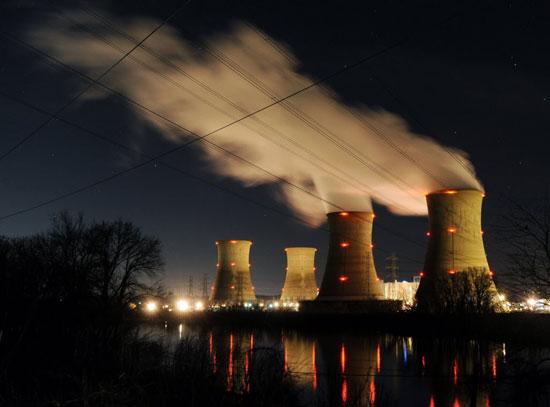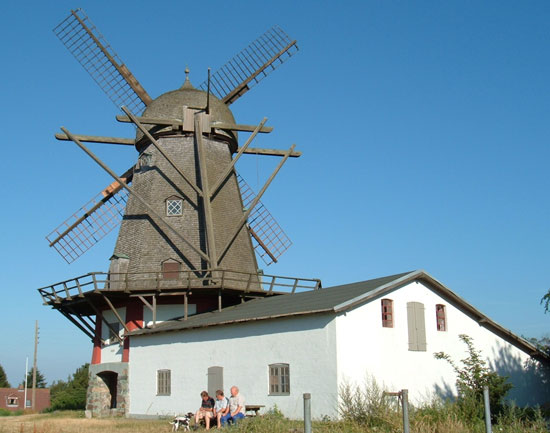Germany: Energy for salvation and unknowns
In the complex economic and political context in the country, with other unknown factors in the source of electricity itself as the end, whether the latest "sentence" of the German Senate is really set the end of the era of nuclear energy in the future?
Energy salvage
At the meeting on July 8, 2011, when voting through the law with a 10-year roadmap from now until the end of 2021, gradually remove nuclear power from now until the end of 2021, the German Senate also adopted a series of additional measures, replaced with other new power sources.

Phiillipsburg nuclear power plant (southwestern Germany) with a high steam evaporation tank, where the author came more than 10 years ago, was closed 10 years later . (Photo: Economicnewspaper)
The first measure is to build more coal and gas thermal power plants. In Germany, the electricity that emits many greenhouse gases causes this climate change to account for a large proportion, more than half of the national grid's capacity. Exactly, thermoelectricity accounts for 56.6%, of which 13.2% uses gas; 20.1% use coal and 23.3% use brown coal.
The second measure is to encourage the expansion of 'green electricity', including wind power, bioelectricity, hydropower and solar power, in which wind power plays a major role. The German government plans to double Germany's 'green power' capacity from this year 2010 to 17% to 10 years after 2020 reaching 35%.

Windmills (between Bogo Island, Denmark), one of thousands of thousands scattered throughout northern Europe, precursors of wind power plants today.
Currently (2010 data), green electricity output reaches about 100 TWh, of Germany's total output of 560 TWh. Green electrical components are distributed as follows: wind power accounts for 5.8%, bioelectric - 4.5%, hydroelectricity - 3.3%, solar power - 1.9% .
In the new energy strategy, wind power is considered a "trump card", saving the number one for Germany's power industry in the near future without nuclear power. Germany's technological capacity and capacity for wind power production are among the top in the world. In 2010, Germany accounted for 25% of the world wind power capacity and reached a wind turbine installation capacity of about 27,000 MW, ranking second only to the United States. Germany also has the potential to export large wind power equipment, providing wind turbines to many countries around the world; including Vietnam, in 2008 alone collected 12 billion euros of equipment export.
In terms of solar power, it is precisely the solar energy, with a capacity of 5,400 MW installed, though modest, but this installation capacity of Germany is larger than that of Spain and Japan.
Two years ago, in 2009, Germany's leading industrial conglomerates formed a Desertec Industrial Initiative (DII), to harness electricity from sunlight and wind in the Sahara with items. pepper will be distributed to North Africa and Near East by 2050, while transcontinental transport will be about 15% of the electricity supplied to European countries.
Heavy psychological insecurity after unexpected nuclear insecurity incidents occurred, the prospect of a future of salvage power sources, especially about wind power has been of great appeal to no few people and especially the people of Germany. This is also the decisive factor to balance the balance toward the removal of nuclear power in the Senate of Germany in early July.
Hide numbers in front
There is no doubt that solutions to replace holes due to the abandonment of nuclear power have been debated by German policymakers. However, it cannot be said that every situation has been taken into account based on completely reliable scientific bases and the future of the national power industry 30, 20 or even 10 years. The arrival has been guaranteed as if it fit in the palm?
Uncertain factors can still be found here in the strategy and plan of nuclear power abolition approved by the German Senate.
First of all, the construction of a series of new coal and gas thermal power plants, from an environmental point of view, is a step back or at least 'medium-term'. This plan, if not applying exhaust cleaning technology, is really against the world trend after Kyoto, Copenhagen conferences . It is EU countries that are 'soldiers' eager to Germany. pioneering flag in reducing greenhouse gas emissions threatens to enhance the earth's climate change, they are aiming for mutant targets: by 40% of greenhouse gas emissions by 2020 compared with in 1990 and up to 2050, radically reduced to 80-95%.
These targets, if not phased out or at least not built with new thermal power plants, can only be achieved with technological measures to treat greenhouse gases. Thus, the investment cost increases, which reduces a cheap price advantage of thermal power plants. Will the German state budget be willing to respond or will consumers be willing to accept long-term high electricity prices compared to the present time?
Discussing the economics of clean power sources such as wind power and solar power, many people clearly know that the investment costs of exploiting renewable energy sources themselves are very high, much higher than heat. electricity. In the strategy to develop wind power to such an extent that it becomes an alternative source of electricity for all nuclear power, not to mention a considerable burden for thermal power, clean electricity investment fund in a developed industrial country. As Germany will grow terribly.
For Germany, another characteristic is needed. In wind power planning, they plan to develop in the North, mainly along the Baltic coast. This requires building power transmission systems to transfer electricity from the northern area to the southern areas. This investment cost must also be enormous.

Wind turbines on the small island of Fehman on the Bantic coast, near the port of Rostok.
Can the German economy, however powerful, meet this huge source of capital and the above financial problems have been carefully calculated or still in the form of unknowns?
In addition, the issue of integrating domestic development and exporting to the world of energy technology such as wind and solar energy, and even nuclear power to Germany, plays a huge role in The economic structure. Many economists worry that the need to export equipment to renewable energy plants may be unstable. This, if it happens, is accompanied by abandonment of the development and export of nuclear technology, as the German industry worries, will affect the competitiveness of German industrial corporations. With its economic leadership, it will affect both the competitive advantage of the entire European economy. Is this also a big number, a consequence of the decision to eliminate Germany's nuclear power industry?
Finally, it is also worth noting that a German contingency plan to eliminate nuclear energy is an option to import electricity from neighboring countries. In fact, Germany is importing electricity from France and Czechoslovakia. The two countries are and will remain attached to the nuclear power industry, France with the share of nuclear power is nearly 80% of the national electricity output, and Czechoslovakia is operating nuclear power plants with Soviet kilns (old ).
Thus, although Germany has decided to abandon nuclear power, the country still has to depend on electricity produced by other country's nuclear power plants. Moreover, despite not building a new nuclear power plant, is Germany still and is likely to continue to export nuclear power technology? There is something unstable in the 'spirit' here, and there is a great opportunity for the country's return to nuclear power in a certain opportunity. What other mysterious or U-shaped orbit does not appear at all to Germany's nuclear industry?
It's hard to say that all possibilities have closed the door. The mystery is ahead. Only time can be answered, like the Western saying - The time will tell!
- Germany will completely use green energy by 2050
- Germany: Development of
- 4 the opposite in Germany but few people know
- Germany set the record for producing the most solar electricity in the world
- France stops people from returning to the village
- Energy-saving homes
- Germany closed all nuclear power plants by 2022
- Reactors supply endless energy in Germany
- Germany closed a series of nuclear power plants
- 16 weird facts about Germany
- The world's 10 most solar-powered countries
- November 9, 1989 - The Berlin Wall collapsed, Germany united
 The most famous scientific failures in history
The most famous scientific failures in history Mysterious genius mechanic and the machine froze time
Mysterious genius mechanic and the machine froze time The son carries the 'bad gene' of genius Albert Einstein
The son carries the 'bad gene' of genius Albert Einstein Isaac Newton
Isaac Newton